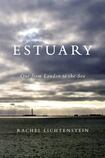
At one point in Estuary, a book the author describes as "a collective memory map" of the Thames Estuary, she encounters an intense man who calls himself River Jim. He is a licensed "mudlarker", with permission from the Port of London Authority to dig for objects washed up on the river's silty foreshore. "There's an older landscape underlying the present one," he tells her. "The Estuary is not a permanent thing. It's moving, it's changing, it's eroding."
Estuary, referring to the expanse of water, riverbank, mudflat and coastline where the river meets the North Sea, is full of such encounters with those whose lives revolve around the river, from fishermen and divers to environmental artists and retired boatmen piloting restored barges. But few capture the essence of Rachel Lichtenstein's project as succinctly as River Jim, who stands squinting at the riverbank, attempting to discern items of value hidden in the mud.
The book begins with a boat trip down the river from the centre of London. Opening in this way allows Lichtenstein to map the territory and set the scene. She painstakingly describes the landscape, natural and man-made, such as this description of the Thames Barrier: “Sunlight bounced off the mirrored, sculptural sides of the shell-shaped piers, creating blinding, white reflections in the water.” One gets the sense of a Romantic sensibility rendering the often desolate vistas of the estuary; indeed, JMW Turner and John Constable were once visitors.
It’s a contemplative prelude to a series of lively but wistful portraits of the estuary’s inhabitants. In the company of a cast of locals, Lichtenstein travels to the strange military sea forts, the sandbanks, the piers, ports and low-lying towns of this unusual landscape.
Establishing trust
The author came to prominence writing about London'sEast End in Rodinsky's Room (1999), cowritten with Iain Sinclair, and, later, On Brick Lane (2007), combining an archivist's attention to detail with a psychogeographer's visionary fervour. Lichtenstein also possesses the oral historian's knack for establishing trust so that people speak freely about themselves and their work.
What she finds among her interviewees is an overwhelming nostalgia for ways of life that are passing into history. Jack Fenwick, a nonagenarian former boat-builder, tells her that the days when you could make a living from shooting wildfowl on the river “are long gone”. Lichtenstein has an eye for declining professions, such as river piloting, which “in the past had been handed down from generation to generation”. Another fisherman tells her that “he felt he had been born fifty years too late”.
These wounded visions of a glorious past and a barren present feel slightly sinister in the aftermath of the EU referendum. Perhaps wisely, Lichtenstein, who spent five years writing the book, doesn’t touch explicitly on politics.
This nostalgia finds its antithesis in the futuristic London Gateway Project, a vast, largely automated deep-water container port going up on the Essex side of the river. The new port looms over the narrative, and over the characters’ lives. It seems symptomatic of the modernity that has swept away the livelihoods along the estuary. When Lichtenstein finally visits the port in an epilogue, she notes that thousands of jobs will be created for locals.
A retired tugman cautiously welcomes the port – maybe it’s an indication of life coming back to the river, he wonders. Aside from that, there are obvious environmental effects, as the dredging of the estuary by DP World, the global trade company developing the port, unearths old shipwrecks and disturbs marine life.
Sunken bomb ship
There are many memorable moments in the book, such as a chapter on the SS Montgomery, the "ship full of bombs" that sank in 1944 and is an ever-present navigational danger, and the emotional account given by Jane Dolby of her husband Colin, a fisherman who lost his life at sea in 2008.
Lichtenstein takes a trip to Sealand, the North Sea platform run as an independent country by the Bates family from Essex. “We set our own laws, we do our own thing, we don’t worry about what the mainland has to say”, the family proclaims in an apparently rebel gesture that now appears a microcosm of the British imaginary.
She also meets an artist who spent 240 nights living on a sea fort and confides that he became “the spirit of the fort somehow”. She gives a dazed description of a boat crash she experienced, and a stomach-turning account of the violent movements of a cockle fishing boat she spends a night on: “Flicking bits of seaweed and broken cockleshell out of my hair, I thought for a moment that I would quite like to go home.”
The Thames Estuary changes constantly: “sandbanks move all the time and buoys are continually adjusted; nautical charts become little more than a moment in time – abstractions of the actual landscape beneath the waves”.
Writing about it presents a unique challenge. How do you make such a landscape comprehensible, and how do you render it vividly for the reader? Lichtenstein’s outstanding book shows how it should be done.
Karl Whitney is the author of Hidden City: Adventures and Explorations in Dublin (Penguin).











